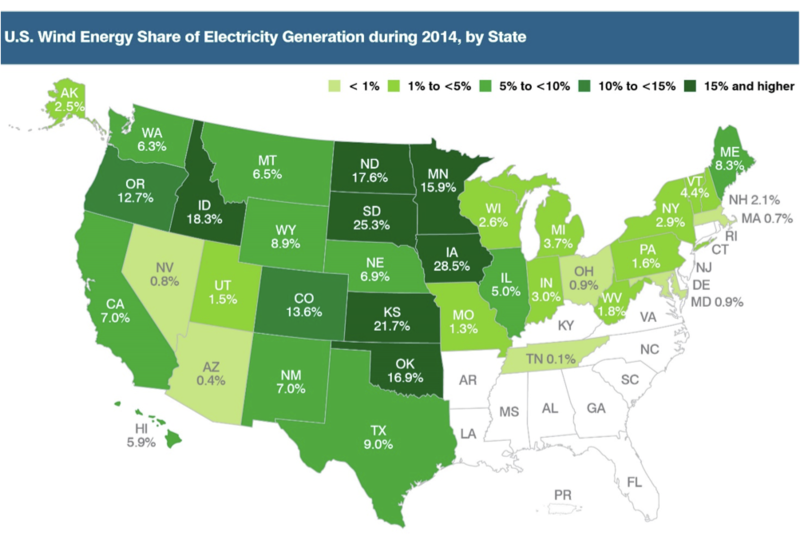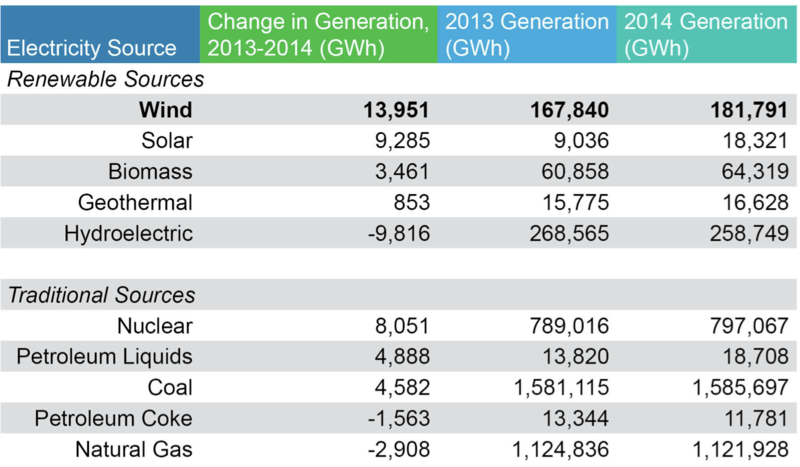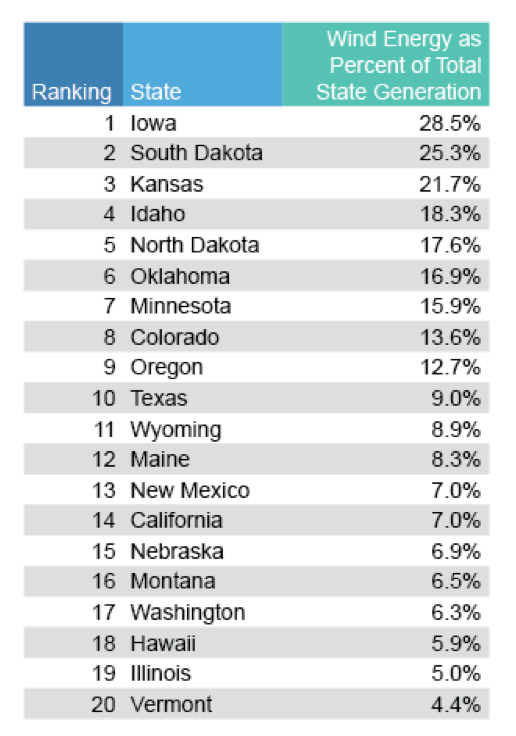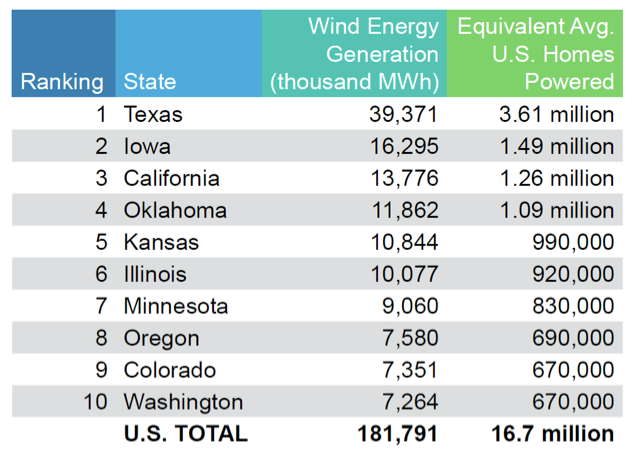News Release from American Clean Power Association (ACP)
Wind Industry Profile of
Inside AWEA News - Wind was largest 2014 source of new electricity, Congress still must provide long-term policy certainty
American wind power added significantly more new electricity than any other resource in 2014, according to U.S. Department of Energy data released late yesterday.
Wind power generated 4.4 percent of all the electricity in America in 2014 and maintained its position as the fifth largest electricity source in the U.S., according to the latest data from the U.S. Department of Energy’s (DOE) Energy Information Administration (EIA). Iowa led the nation by producing 28.5 percent of its electricity from wind power, followed by South Dakota at 25.3 percent and Kansas at 21.7. Wind energy provided more than 15 percent of electricity in a total of seven states, more than 10 percent in a total of nine states, and more than five percent in a total of 19 states.
All renewable energy sources including hydropower now deliver more than 13 percent of the nation’s electricity, with wind energy providing more than one-third of that total.
“The U.S. is blessed with an abundant supply of wind energy. Pairing this homegrown resource with continued technology innovation has made the U.S. the home of the most productive wind turbines in the world,” said Emily Williams, Deputy Director of Industry Data and Analysis for AWEA. Analysis released last year found the U.S. is number one in the world in wind energy production.

Chart Source: AWEA; Data Source: EIA Electric Power Monthly
“Having more clean, affordable wind power than ever is helping to keep the lights on for U.S. homes and businesses,” said Tom Kiernan, CEO of the American Wind Energy Association (AWEA). “We have an opportunity to have even more of the U.S. reliably powered by wind, resulting in more well-paying jobs, more benefits for consumers and cleaner air.”
Wind energy’s growth has been driven by technological improvements and cost declines that have reduced the cost of wind energy by more than half over the last five years, as documented by Lawrence Berkeley National Laboratory.
In 2014, wind provided enough electricity to power the equivalent of 16.7 million homes, or all the residential households in Iowa, Kansas, Minnesota, Nebraska, North Dakota, South Dakota, Colorado, Idaho, Illinois, and Montana. Once recently added U.S. wind projects have had a full year of production, total wind output will likely rise to powering the equivalent of 18 million homes.

Figure 1: Energy sources by amount new generation in 2014
Congress is currently faced with the decision to extend the Production Tax Credit (PTC), the primary federal tax incentive for wind energy. The PTC’s performance-based incentive is a primary reason why U.S. wind plants are more productive than those in other countries. Construction of new U.S. wind farms has driven an average of $12.2 billion a year in private investment over the last five years, and $100 billion since 2008.
Texas broke into the top 10 states for percentage of the state’s electricity supplied by wind. The main Texas grid, the Electric Reliability Council of Texas (ERCOT), generated 10.6 percent of its electricity from wind in 2014. Texas continued to lead the U.S. with the most wind installed wind capacity, as well as the most electricity generated from wind energy - over 39 million megawatts-hours, enough to power more than 3.6 million homes. At times, wind energy has provided nearly 40 percent of the electricity on the main Texas grid, and over 60 percent of electricity on the main Colorado power system.
Texas, Iowa, California and Oklahoma all generated enough electricity to power more than 1 million homes.
The U.S. will tap into more of its wind power resources this year, and in years ahead, as the U.S. wind energy industry entered 2015 with a record of more than 13,000 MW of wind projects under construction. Construction activity is currently ongoing in 22 states.

Figure 2: Top 20 States for Wind Energy as Percent of Total State Generation
Wind power is emerging as a critical solution for states and utilities to cost-effectively reduce pollution, which will help comply with pending EPA rules. In 2014, the U.S. wind fleet reduced carbon dioxide pollution by around 125 million metric tons, equivalent to 26 million cars worth of carbon emissions.
"Wind has more than tripled since 2008, it can double from where it is today to 10 percent by 2020, then double again to 20 percent by 2030, and become the leading source of electricity in the U.S. by 2050," said AWEA's Kiernan. "However, to get there Congress must provide wind with the same policy certainty it provides to other energy sources by rapidly extending the Production Tax Credit for as long as possible."
The DOE is expected to release a new report this month titled, “Wind Vision: A New Era for Wind Power in the United States,” that will show how the U.S. can reach those goals. In a 2010 study, the National Renewable Energy Laboratory reported that the U.S. has over 10 million megawatts of viable wind resource potential, enough to power the equivalent of the nation’s total electricity needs 10 times over.

Figure 3: Top 10 States for Wind Generation
As wind energy has grown to provide a larger share of our electricity mix, wind turbine technology has matured so that modern wind plants are able to provide the same grid reliability services as conventional generators, as documented in an AWEA report released last month.
American wind power now supports well-paying manufacturing jobs at over 500 manufacturing facilities in 43 states, and 50,000 well-paying jobs. Wind farms deliver over $180 million a year to landowners in lease payments, as over 98 percent of wind projects are located on private land.
You can access more information on wind generation data by going visiting AWEA’s state-level wind energy statistics online.
To receive more information on this article, our Newsletter or find out more about what w3.windfair.net has to offer, please, do not hesitate to contact Trevor Sievert at ts@windfair.net.
Please don't forget to follow us on Twitter: w3.windfair.net on Twitter
w3.windfair.net is the largest international B2B internet platform in wind energy – ultimately designed for connecting wind energy enthusiasts and companies across the globe.
- Source:
- American Wind Energy Association
- Author:
- Trevor Sievert, Online Editorial Journalist / By AWEA Staff
- Email:
- windmail@awea.org
- Link:
- www.awea.org/...

